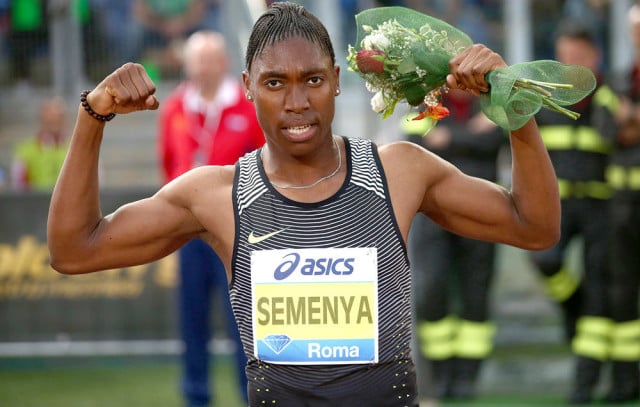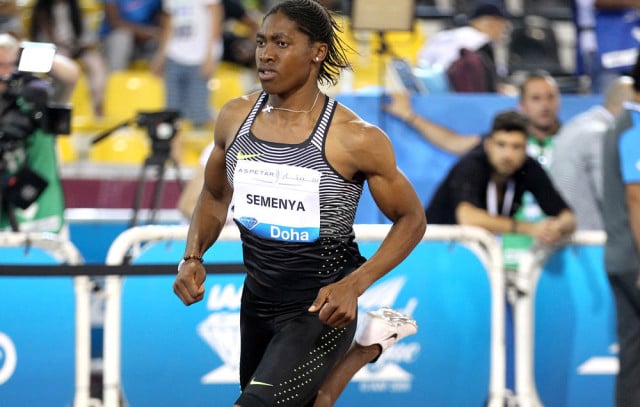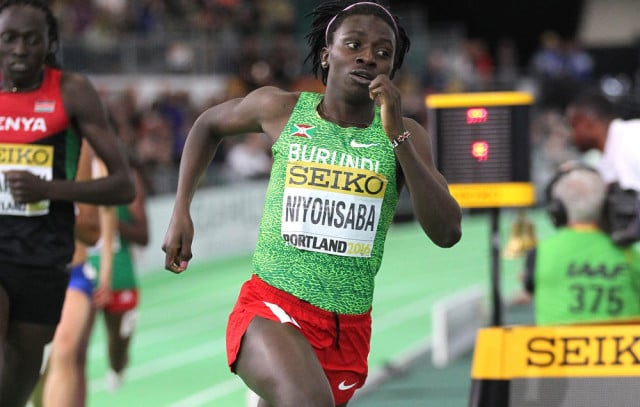Why the Women’s 800m Will Be the Most Controversial Olympic Race
After a ruling last year struck down a contested regulation, intersex women such as Caster Semenya are running faster than ever. – Amby Burfoot

The women’s 800-metre competition will be one of the most eagerly anticipated events at the Rio Olympics, and not just because the racers are fast. Some are also biologically different, at least to some degree. In earlier Olympics, they might have been disqualified, or even accused of being men. That won’t happen in Rio. But the whole world will be looking very closely at Caster Semenya and her closest competitors. Below we answer questions about Semenya and the furor likely to envelope her best event, the women’s 800.
What is the controversy surrounding Caster Semenya and a few other women runners?
Semenya and others are representative of a rare condition on the continuum of human biology. They’re neither classically male or classically female. Although privacy laws prevent us from knowing medical specifics about Semenya, she appears to have DSD, a disorder of sex development, sometimes called intersex. As a result, her body might produce atypically high (for a woman) levels of natural testosterone, which might, in turn, enhance her running performance. She’s big, muscular, deep-voiced, and this year’s fastest woman at 800 metres, having run a lifetime best of 1:55.33 on July 15. Some believe she shouldn’t be allowed to compete as a woman.
Hasn’t Semenya been the subject of controversy before?
Yes, in 2009. But there have been several important plot twists since then.
During 2009, the then-18-year old Semenya improved her 800-metre best by more than eight seconds, and won the World Championships title by more than 2 seconds, a huge margin in a world-class race at such a short distance. Her speed and appearance created a media frenzy, while some of her competitors voiced suspicions regarding Semenya’s sex. As a result, the International Association of Athletics Federations (IAAF) launched an investigation.
After examining Semenya, the IAAF presumably told her to begin taking female hormones to lower her likely high level of testosterone. (We have to say “presumably” and “likely” because the entire investigation should have been done in private, and what little we know comes from various leaks and/or from knowledge of customary procedures. To this day, Semenya’s past and present hormone levels are not in the public domain.) While Semenya was presumably undergoing hormone therapy, the IAAF barred her from racing for 11 months. She was allowed to return to competition in July 2010.
The IAAF also organised an expert consensus committee for advice on dealing with DSD women. In its report, the committee recommended that no woman be allowed to compete as a woman if she has a testosterone level of 10 nmols/litre or more unless she has a documented testosterone-insensitivity (androgen resistance), which would render her testosterone non-functional, and thereby not contribute to muscle strength, speed, and other parameters of performance. The IAAF officially adopted this position in 2011, and the Olympics followed suit in 2012. The new rule was called the Hyperandrogenism Regulations, and it was intended to be used in cases like the Semenya situation.
What were the primary reactions to the Hyperandrogenism Regulations?
Many view hormonal regulation as a necessary evil – necessary to preserve the rights of the vast majority of women athletes with average female testosterone levels against the rights of the exceedingly few women who have substantially more testosterone. (Everyone is careful not to call the regulation a “sex” test; rather, it’s an “eligibility” test.)
Others argue that there’s no high-testosterone limit for men; that the science regarding the performance effects of hyperandrogenism (high testosterone, or high-T) in women is essentially non-existent; that gender should be self-determined; and that sports can never exist on a level playing field due to individual variation across all human biological measures.
It’s important to emphasise that hyperandrogenic women have naturally high testosterone, rather than having high testosterone because of taking performance-enhancing drugs.
What happened to Semenya after she supposedly began taking female hormones?
She continued running, but a bit slower than in 2009. She finished second in the 2011 World Championships and the 2012 Olympics, both times to Russia’s Mariya Savinova. Semenya didn’t receive a lot of attention in these events because she wasn’t the winner. (Last November, the World Anti-Doping Agency recommended that Savinova receive a four year ban for doping violations. It’s possible that Semenya will at some point be declared gold medallist in the 2011 and 2012 competitions.) Semenya’s best performances drifted upward from 2010 through 2015, possibly due to changes in her hormones levels, as well as typical variations in motivation, training, injury, and so on.

Why is Semenya’s condition in the news again?
Because in early 2015, a 19-year-old Indian sprinter named Dutee Chand, with a condition similar to Semenya’s, challenged the IAAF’s Hyperandrogenism Regulations in the Court of Arbitration for Sport, the “Supreme Court” of the sports world. On July 24, 2015, the CAS issued a 161-page report that sided with Chand, thus striking down the Hyperandrogenism Regulation. (The IAAF, the losing side in the Dutee Chand case, was given two years to gather more evidence and re-submit to the Court. It has not done so to date.)
What did the CAS decide?
First, the court decided that the Hyperandrogenism Regulations are clearly discriminatory, in violation of the IAAF and IOC charters, because they apply only to women. There is no equivalent rule disqualifying high-T men from competition. Second, both Chand and the IAAF agreed that there should be a distinct female category of competition, and such competition should be “fair.” Third, the Hyperandrogenism Regulations are unlike other athletic bans in that they are essentially a lifetime ban, not a time-limited ban. Fourth, Chand failed to prove that a high-T woman taking estrogen and other female hormones would suffer a significant decline in performance.
Fifth and most important, the IAAF failed to establish that a woman born with naturally high testosterone levels has a significant performance advantage over other women.
According to the court, the IAAF did not produce convincing scientific evidence that endogenous testosterone (produced by a woman’s own body) has the same powerful performance benefit as exogenous testosterone (from drugs). All parties agreed that exogenous testosterone has a significant effect on performance, and that exogenous testosterone should be universally banned.
The challenge posed to the IAAF by the CAS is a very stiff one. That’s because almost nothing is known about the effects of endogenous testosterone on women’s strength and speed. The handful of experts and studies in this arena do not agree with each other.
As a result of the 2015 CAS decision, Chand, Semenya, and other similar athletes no longer need make any efforts to lower their natural testosterone. In Semenya’s case, she is running dramatically faster a year after the Hyperandrogenism Regulations were voided. (Her best time so far this year is more than 4 seconds faster than her best time of 2015, which is a massive difference in the 800.)
Does the CAS ruling have anything to do with transgender athletes?
No. However, several transgender women who were formerly men could compete as women in Rio. At this time, the situation is very fluid. We don’t know any names at this point, because sports organisations have successfully maintained privacy. If these transgender women compete in Rio, they might or might not come out to the public, or their names could be leaked by friends (or foes). For two news reports on transgender athletes and the Rio Olympics, go here and here.
What are the Olympic rules concerning transgender athletes?
Female-to-male athletes may compete as a male, as there is no known advantage to having had a prior female physiology. Things are not so easy for male-to-female athletes. They must show that their testosterone level has been below 10 nmol/L for at least 12 months before they begin competing as a woman. The Olympic transgender rule was released last November. As with the Semenya case, some fairness-in-women’s-sports advocates believe the transgender rule could tip the scales against lifelong modest-T women.
How many women have a testosterone level above 10 nmol/L?
Very few. In the Dutee Chand case, the IAAF’s expert witnesses stated that testing at the 2011 World Championships found the following results among women athletes: The median testosterone level was .69 nmol/L and the 99th percentile level was 3.08. So a level of 10 is an extreme outlier. The IAAF was in effect arguing that it was being very generous to high-T women by setting the bar at 10. However, the biggest missing piece is the “ testosterone sensitivity” question. No one knows if women react to their own natural testosterone as powerfully as men react to their testosterone. Lacking such data, the CAS felt the IAAF’s 10 nmol/L rule could not be defended.
Is Dutee Chand a medal threat like Semenya?
Chand expects to compete in the Olympics, but isn’t among the top 50 in the world in her best event, the 100 metres. She may attract attention for the CAS decision that bears her name, but she won’t be a factor in the final standings.
Semenya is a different matter. (If nothing else, Chand’s and Semenya’s different competitive levels prove that there is wide performance variation in women with high testosterone.)

Francine Niyonsaba en route to victory in the 800-metre final at the 2016 World Indoor Championships. Like Caster Semenya, she is considered by some observers to have naturally high levels of testosterone.
In April, presumably after six or seven months without female hormones, Semenya won the 400, 800, and 1500 at the South African National Championships, all within a four-hour period. She has continued running fast in the following months, and is favoured to win the 800 in the Olympics. On July 15 in Monaco, she ran the fastest time of her life, 1:55.33, closely followed by Burundi’s Francine Niyonsaba, who also set a personal record and is also believed by some to be a high-T woman. Kenya’s Margaret Wambui might fall into the same category. Like Semenya, Niyonsaba and Wambui are muscular, flat-chested, fast, and produced world-class performances very early in their track careers. Thus far in 2016, Semenya and Niyonsaba have run the five fastest 800s of the year.
No one knows why the 800 seems to have become the event in which intersex women are most dominant. One suggestion: The sprints require a certain amount of technique and specialised coaching, not readily available to athletes from developing countries, whereas an 800-metre runner can rely more on raw power.
READ MORE ON: caster-semenya olympic games olympics

